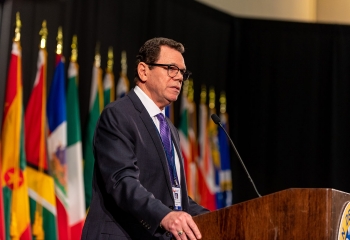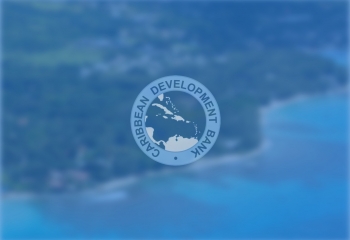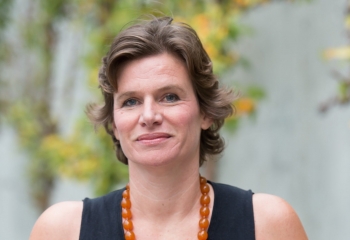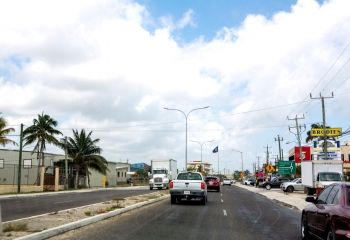Opening Remarks- Caribbean Regional Risk Conference
Mr. Buamah, thanks for your remarks. Thank you to the Heads of Government, private sector stakeholders, development partners and distinguished guests for joining us today. Special thanks also to our development partner on this initiative, Caribbean Catastrophe Risk Insurance Facility (CCRIF) segregated portfolio company (SPC). Let me also welcome our online audience. Indeed, opportunities for virtual conferences have allowed attendance from a wider cross section of enthusiasts than physical presence would permit. The rather high number of registrations and attendees underscores the beginning of what could become an extremely impactful initiative for the Caribbean.
My key message today is that risk mitigation is essential to sustainable development. As we have argued before, sustainable development is a holistic concept that embodies an ability to self-perpetuate, while advancing. Hence, resilience is paramount. If we admit that the broad dimensions of resilience are interconnected, then it becomes clear that the coherent solutions for a sustainable development paradigm require an integrated solution for a resilience ecosystem. By extension, risk mitigation must also imply an integrated and internally coherent risk management system.
As such, we have organised this conference to start the process of bridging this sustainable development gap. Specifically, the objective of this conference is to promote a specific perspective on risk management at the sovereign level. To this end, this conference is about: (1) highlighting the importance of risk mitigation to achieving sustainable development goals (SDGs); (2) carving out a blueprint for how that can be done; and (3) guiding the development of a risk ecosystem to ensure risk management remains integrated and effective. We hope that by the end of the conference you will agree that isolating the management of different types of risk is not the most effective way to mitigate risks. In fact, we hope you will conclude that risk management must be holistic and encompass a coherent set of policies that can address the diverse aspects of an evolving risk ecosystem.
Caribbean countries are known to be among the most vulnerable states and the accumulated impact of a variety of natural hazard and macroeconomic shocks have significantly slowed our development, threatening the achievement of the sustainable development goals by 2030. The path towards achieving SDGs 1 to 3 and SDGs 8 to 10 has been directly impacted by unmitigated risks. The less than adequate resilience associated with unmitigated risks has also indirectly impacted the remaining SDGs by reducing and, in some cases, reversing the accumulation of government’s resources that can be directed towards the achievement of these SDGs. The need for a system of risk mitigation is therefore critical to the achievement of our mandate to contribute to the harmonious growth and development of the countries and people of our Region.
Over the last two decades, the path to sustainable development has been constrained by risks such as rising debt levels, intensifying climate events, over dependence or concentration in a single product, social inequalities, and exposure to external shocks. In addition to this, the impact of COVID-19 and indeed recent geopolitical tensions, in particular the Russian/Ukraine crisis, have only served to accentuate the implications of our structural challenges. There are new and emerging risks, such as rising global inflation, accelerated increase in interest rates, technological inequalities, and food and energy insecurity. These risks clearly interact and intersect, and have a compound impact on our development outcomes.
The natural question that follows is how can Caribbean countries effectively conduct risk mitigation? This brings me to the second pillar of the conference, namely that risk management must incorporate the fact that risks are interconnected. At the institutional level, an integrated enterprise risk management framework, for example the framework used to manage risks at CDB, uses a suite of tools to enable the effective management of the disparate array of existing and emerging risks. Our message here is that these tools are applicable also at the sovereign level for use by Governments to conduct a sound integrated framework that combines climate and non-climate risks. It is important that Heads of Governments embrace this new way of thinking as it relates to risk management at the sovereign level. Using this integrated approach is the only way to effectively conduct risk mitigation, which as noted is crucial to achieving sustainable development goals.
Currently, the identification and mitigation of risks by Caribbean countries are often done in an isolated manner where the inextricable link, particularly between climate and non-climate risks, are not made. This leaves countries vulnerable to the impact of shocks persisting and concomitantly maintains a high-risk profile. Currently, international investors demand high returns for investments in the Caribbean to compensate for these relatively high risks. Those high returns translate into high funding costs for Caribbean Governments, which puts pressure on fiscal sustainability and reduces fiscal space for the achievement of SDGs. Another way to view this is that the implementation of appropriate risk mitigation policies improves risk profiles and by extension credit ratings; further, the improved risk profile has a permanent effect on credit worthiness, which enhances access to more affordable financing. This perspective provides a solution that implies a permanent impact on our ability to access more affordable finance, while reducing the reliance on temporary-impact, lower rate concessional funding.
In this context, risk mitigation can be a catalyst towards achieving SDGs, by creating more fiscal space from lower funding costs to pursue SDGs or by way of accessing more affordable capital to pursue SDGs. Risk reduction cannot be achieved, however, without the adoption of an integrated approach to risk management. Therefore, risks mitigation policies become a foundation for lower risk profiles and improved potential to achieving SDGs.
Against this background, what are the actual tools and policies needed by Caribbean Countries to make the leap into integrated risk management? This brings me to the third pillar of the conference. Risk management must encompass a coherent set of policies that can manage all risks in a well-developed risk ecosystem. This allows me to reiterate that risk mitigation cannot be done using an isolated approach for each type of risk. As such, the effectiveness of risk mitigation relies on a well-developed risk ecosystem which recognises the interconnectedness among individual elements. The main elements of this risk ecosystem are the individuals, institutions, frameworks, and processes that govern the identification and mitigation of all risks in a country, ensuing this is done in an integrated and thus effective manner.
The development of this ecosystem relies on four key tools:
- The first tool is a framework that categorises risks that are relevant to a country and identifies the interconnected nature of those risks.
- The second tool is a framework that develops indicators reflecting the severity of each risk and an evaluation of the impact of planned measures to reduce those risks.
- The third tool is a framework that evaluates the availability of additional preparedness, response, and recovery measures that can be implemented, and the likely impact of these measures.
- The fourth tool is a governance framework that ensures the previous three tools involve all decision-makers, technocrats, and those affected by these risks in an integrated risk management process. Allow me to elaborate here on a key aspect of the third tool. At the Caribbean Development (CDB), we have been developing the concept of an Internal Resilience Capacity metric that recognises the duration of recovery after a shock is dependent on the vulnerabilities inherent in our structural challenges, the magnitude, impact, and persistence of the shock, access to finance, and the internal capacity for recovery. Needless to say, that a Vulnerability and Resilience Assessment tool that can measure these impacts and guide the appropriate policies and needed finance will be an important part of this risk management architecture.
To develop and implement these tools, we are recommending four important policies that can be implemented to buttress this risk mitigation effort. First, countries should improve governance of internal risk assessment processes. Second, countries should elect national risk coordinators to create an effective conduit for knowledge transfer across the Caribbean and for guidance in the implementation of an integrated sovereign risk management framework. Third, countries should actively focus on risk reduction as a means to reducing funding costs and financing an expedited path towards achieving SDGs; and fourth, adequate and appropriate risk tools should be maintained in order to properly assess the operating environment and sufficiently incorporate the mitigation of new and emerging risks.
In support of these policy recommendations, CDB and CCRIF SPC are currently developing an integrated sovereign risk management blueprint that can be implemented through the national platform of respective countries. We are also developing a term of reference for the respective country risk coordinators.
In conclusion, it is our vision that this ecosystem will enable an integrated approach to effective risk management and lead to a more expedited path towards the achievement of SDGs.




